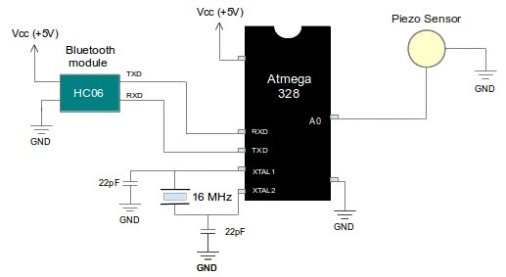The idea first arose in my mind when I was staying as a paying guest in a room. My room did not have a doorbell and nor could I get it installed without making significant changes in the electrical wiring of my room. Visitors coming, knocking my door and I not realizing it through the sound of the headphones plugged into my ears and playing Linkin Park songs was becoming fairly common.
This led me into thinking of making a DoorKnock module which can be plugged at the back of the door and which will send an alarm to my mobile phone when someone knocks on the door . The module would have a (piezo)sensor to sense the vibration of the knock and a bluetooth module to connect to my mobile phone. Additionally there would be a microcontroller to interface with the sensor and the bluetooth module.
I had most of the materials I needed. I decided to use Arduino for past prototyping and I had to order for a bluetooth module ( I settled for HC06). Here is the hardware circuit for the DoorKNock module I came up with.

Fig: Hardware circuit for DoorKnock Module
The program in Arduino was a simple one. It would take the analog output data from the piezosensor, convert it to digital data and compare it with a predefined threshold. If the output value crosses a certain threshold – a data ‘test’ would be transmitted through the HC06 bluetooth module to the device (mobile phone) to which it is paired and connected.
The mobile phone should additionally have an application running and listening to the HC06 module. Whenever it receives the data ‘test’ , an alarm should be triggered. Since I had not written this app yet, I decided to test the circuit using my computer.
I paired and connected the HC06 bluetooth module to my computer using my Bluetooth Manager. As soon as the device was connected it formed a serial port called /dev/rfcomm0. I opened my terminal window and entered the command sudo cat /dev/rfcomm0 to have a live display of the data coming to my rfcomm port. Here is what happened when I sent the knock…………..

Fig: Screenshot of my terminal when DoorKnock module sends ‘test’ data on knocking
Assured that my hardware module was working properly I approached my junior Aravind Srivatsan to make an Android app that listens to the data sent by the HC06 module. He came up with the app within a week and we tested its working.
Here is how the module looks at the back of my door.

Fig: DoorKnock Module at the back of my door
I will come up with the video to demonstrate its working soon. Additionally you can download the program, app and all the related files regarding DoorKnock module from www.openhware.com
There are lots of ways in which the above module can be improved- for example using interrupts will conserve the battery life. Also, I would prefer using 8051 series of microcontroller for the purpose. I will update the readers on the future developments of this work in my future blogs. Till then Adieu!!


